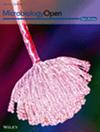Correction to “CerM and Its Antagonist CerN Are New Components of the Quorum Sensing System in Cereibacter sphaeroides, Signaling to the CckA/ChpT/CtrA System”
IF 4.6
3区 生物学
Q2 MICROBIOLOGY
引用次数: 0
Abstract
Hernández-Valle, J., B. Vega-Baray, S. Poggio, and L. Camarena. 2024. “CerM and Its Antagonist CerN Are New Components of the Quorum Sensing System in Cereibacter sphaeroides, Signaling to the CckA/ChpT/CtrA System.” MicrobiologyOpen 13, no. 6: e012. https://doi.org/10.1002/mbo3.70012.
In Results:
Section 3.1, pages 9 and 10: The mention of Figures 2B, 2C, and 2D was meant to indicate Figures 1B, 1C, and 1D, respectively.
Section 3.2, page 12: The sentence “explaining the polar effect of the allele ΔcerR::aadA (JV16 strain in Figures 3 and 4)” should have actually referred to Figures 2 and 3.
We apologize for these errors.
修正“CerM及其拮抗剂CerN是球形cereibacterium sphereroides群体感应系统的新组成部分,向CckA/ChpT/CtrA系统发出信号”。
Hernández-Valle, J., B. Vega-Baray, S. Poggio和L. Camarena. 2024。CerM及其拮抗剂CerN是球形cereibacterium sphereroides群体感应系统的新组成部分,向CckA/ChpT/CtrA系统发出信号。微生物学第13期,第2期。6: e012。https://doi.org/10.1002/mbo3.70012.In结果:第3.1节,第9页和第10页:提到图2B、2C和2D分别表示图1B、1C和1D。第3.2节,第12页:“解释等位基因ΔcerR::aadA(图3和4中的JV16菌株)的极性效应”这句话实际上应该指的是图2和图3。我们为这些错误道歉。
本文章由计算机程序翻译,如有差异,请以英文原文为准。
求助全文
约1分钟内获得全文
求助全文
来源期刊

MicrobiologyOpen
MICROBIOLOGY-
CiteScore
8.00
自引率
0.00%
发文量
78
审稿时长
20 weeks
期刊介绍:
MicrobiologyOpen is a peer reviewed, fully open access, broad-scope, and interdisciplinary journal delivering rapid decisions and fast publication of microbial science, a field which is undergoing a profound and exciting evolution in this post-genomic era.
The journal aims to serve the research community by providing a vehicle for authors wishing to publish quality research in both fundamental and applied microbiology. Our goal is to publish articles that stimulate discussion and debate, as well as add to our knowledge base and further the understanding of microbial interactions and microbial processes.
MicrobiologyOpen gives prompt and equal consideration to articles reporting theoretical, experimental, applied, and descriptive work in all aspects of bacteriology, virology, mycology and protistology, including, but not limited to:
- agriculture
- antimicrobial resistance
- astrobiology
- biochemistry
- biotechnology
- cell and molecular biology
- clinical microbiology
- computational, systems, and synthetic microbiology
- environmental science
- evolutionary biology, ecology, and systematics
- food science and technology
- genetics and genomics
- geobiology and earth science
- host-microbe interactions
- infectious diseases
- natural products discovery
- pharmaceutical and medicinal chemistry
- physiology
- plant pathology
- veterinary microbiology
We will consider submissions across unicellular and cell-cluster organisms: prokaryotes (bacteria, archaea) and eukaryotes (fungi, protists, microalgae, lichens), as well as viruses and prions infecting or interacting with microorganisms, plants and animals, including genetic, biochemical, biophysical, bioinformatic and structural analyses.
The journal features Original Articles (including full Research articles, Method articles, and Short Communications), Commentaries, Reviews, and Editorials. Original papers must report well-conducted research with conclusions supported by the data presented in the article. We also support confirmatory research and aim to work with authors to meet reviewer expectations.
MicrobiologyOpen publishes articles submitted directly to the journal and those referred from other Wiley journals.
 求助内容:
求助内容: 应助结果提醒方式:
应助结果提醒方式:


